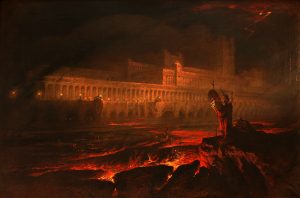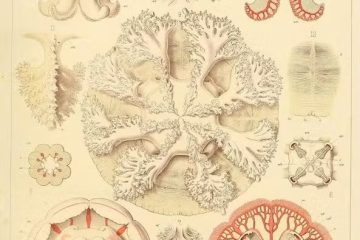Pandemic Pandemonium
 Photo: Le Pandemonium, by John Martin, 1841, Le Louvre
Photo: Le Pandemonium, by John Martin, 1841, Le Louvre
Pandemic and pandemonium—was it mere alliteration insistently linking those two words in my head? They seem disconnected: the pandemic has spread eerie silence and ordered separation far more than the pandemonium of wild and noisy disorder. Then I remembered the original meaning of pandemonium—“all the demons.” Ah. That’s it. What a host of demons the pandemic has been revealing: not supernatural spooks but hellish systems of collective oppression, of normalized injustice—normally hidden, like all smart demons, in plain view.
As the virus presented, so did the malignancy of a national government repressive of science, information, and its own responsibility to protect and care for its population. As an election looms, so too the demons of democracy’s doom. But the systemic, pre-pandemic torments are legion.
The stunning statistics of racial impact reveal nothing new about us/U.S. Consider how “African Americans represent a third of all deaths from COVID-19, even though they represent only 13% of the national population,” NPR News reports. This disparity brings home the flagrant inhumanity of racism built into the housing, pollution, healthcare, education, jobs, and policing of racially segregated cities. Before I can upload this post, the demon of white supremacism strikes murderously and garishly against the background of the pandemic. George Floyd’s death is supercharged with the racial disparity of the disease and of its economic effects.
Race cannot be simply fused with poverty: people of color rise to great financial success, and conversely, racism impacts middle class and wealthy blacks but not middle class and wealthy whites. Neoliberal capitalism, in its global reach, relies upon the exploitation of black and brown people. This doesn’t make race and class identical. But racism prances arm-in-arm with capitalism. The pandemonium gets wilder by the day, as U.S. unemployment shoots toward the Great Depression’s 25%.
Now another demon, a foody one, pops into pandemic view. In the wealthy U.S., a startling one in five families is currently suffering from food insecurity; but the correlation with race and class is no surprise. Michael Pollan, author of The Omnivore’s Dilemma and In Defense of Food, among others, labels this brother demon “the sickness in our food supply.” He shows that “even when our food system is functioning ‘normally,’ reliably supplying the supermarket shelves and drive-thrus with cheap and abundant calories, it is killing us—slowly in normal times, swiftly in times like these.” Seems our “normal diet” of lots of meat and processed food causes chronic inflammation harmful to the immune system and resulting in “underlying conditions.”
Amidst the pandemonium, I’m sure you’ve noticed that usually underrated demon—ageism—now front and center in the pandemic dance. And of course the demon of homophobia wouldn’t miss the pandemic opportunity. It donned recently the face of Ralph Drollinger, a minister who leads a weekly Bible study for Trump’s cabinet. The disease expresses “God’s consequential wrath” against those with a “proclivity toward lesbianism and homosexuality,” The Intercept’s Lee Fang reports. (And also against those who worship the “religion of environmentalism.”)
So yes, what of the earth-sized demon of ecological demise and its choir of deniers? No one blames the pandemic on climate change or carbon emissions. But neither can it be explained apart from the relentless human destruction of nonhuman habitats. Nor can it be separated from the global capitalism and travel that both carry the virus and warm the planet.
The fever of the earth and the fever of COVID-19 have different causes—but they present as symptoms of the same planetary pandemonium. For all its epochal heat, global warming has remained on the back burner of most people’s consciousness. It appears to move slowly—we think we’ll die of old age before it gets dire. In the meantime, denial reigns. Never mind that, say, a dam in Michigan just collapsed due to catastrophic flooding—forcing not only thousands to flee but also stirring worry over possible toxic pollution. The unprecedented floods and storms, heat and droughts are treated—no matter what the science says—as exceptions. The double denialism of Trump’s treatment of COVID-19 and of environmental regulation: a match made in hell.
The word pandemonium, it turns out, was invented by John Milton—Pandæmonium is the capital of Hell in his epic poem, Paradise Lost—“the high Capital Of Satan and his Peers.” All those demons. But it is not Satan himself who envisioned this elegant new city. It is none other than Mammon, the biblical demon of economic avarice, who directs its construction. Mammon organizes demons and humans to mine the Earth for its “treasures”—by which he builds the golden splendor of Pandæmonium:
Men also, and by [Mammon’s] suggestion taught,
Ransack’d the Center, and with impious hands
Rifl’d the bowels of thir mother Earth
For Treasures better hid. Soon had his crew
Op’nd into the Hill a spacious wound
And dig’d out ribs of Gold.
In view of this violent plunder of the planet, Milton goes on to warn, “let none admire/ That riches grow in Hell… .”
By another bizarre synchronicity, Milton was not writing Paradise Lost at home in the capital city of London, which he had fled with his family in 1664 to escape the last outbreak of bubonic plague. On the wake of increased global travel and trade, thought to have come from a region in China by way of the Silk Road or the new schooner ships, that plague remains the second worst pandemic in history, at least for now.
The hell revealed by our present pandemonium can again be masked as normality and order: not as the therapeutic order of quarantines, sheltering in place, and measured re-openings, but as the old order that formed civilization, civis, city, the ancient, ever mutating order that imposes as normal its earth-wounding systems of greed and power. Business as usual.
None of these systemic demons are new. But they have taken ever new forms of exploitation, enslavement, extraction. And at this moment, these pan-demons dance garishly into view through the pandemic interruption of normalcy—and so they too get denormalized for a moment. And they seem just too much. Too many. Too many feverish issues to address all at once. Too many for the righteous “I told you so’s” of any single-issue movement. Too many to hold in view together. Between exhausting us with their too-muchness and seducing us with their “back to normal,” the order of our Pandæmonium may prevail.
But after all, the pan-demonic systems are not too numerous to confirm the interconnectivity of the many, the too many, burning issues. Black womanist theory has named this challenge “intersectionality,” capturing the realization that questions of race come bound with those of sexuality and class—interlinked for better or for worse. And of course, the multiplicity of interlinked issues itself issues from a web of even deeper intersections; each human linked to each other human, to each other, joined inseparably in an eco-choreography of our vivid differences.
This entangled diversity does not however begin in relations of imbalance and oppression. Its interweave exhibits what we are as persons, as collectives, as a species amidst species, as organisms amidst earth systems. And it is that indeterminate crossover between organic and inorganic systems that the coronavirus is so spitefully reminding us. One virologist warned early in this century that the ambiguous status of a virus—between biology and chemistry—was preventing adequate understanding—and preparation: “Regardless of whether or not we consider viruses to be alive, it is time to acknowledge and study them in their natural context—within the web of life.”
As the pandemic exposes our webby vulnerability, it unveils the pan-demonic dance and disfiguration of our relatedness. (Note that apocalypse means originally “unveil,” not The End.) Are we seeing ourselves, now, in a dance of death disguised as a return to normal? Or, perhaps, in a more enlivening dance? Might we together move against the pressure of mere return? In a spiral dance, retrieving the touch, the embodied relationality, the good of what was—while insisting upon the chance of something new, something better? Arundhati Roy put this choice perfectly:
Nothing could be worse than a return to normality. Historically, pandemics have forced humans to break with the past and imagine their world anew. This one is no different. It is a portal, a gateway between one world and the next. We can choose to walk through it, dragging the carcasses of our prejudice and hatred, our avarice, our data banks and dead ideas, our dead rivers and smoky skies behind us. Or we can walk through lightly, with little luggage, ready to imagine another world. And ready to fight for it.
Such imagination of “another world” offers no utopian reassurances. And, as a theologian I had better stress—no fantasy of angels coming down to defeat demons; no escape through Peter’s portal to a supernatural heaven. (As I remind elsewhere, ‘The new heaven and earth’ translate no longer as supernatural intervention or afterlife escape… ) Another world does, however, offer more than optimistic unreality or stoic courage. We don’t walk alone through the pandemic portal to another world. As reflected in so many essays and blogs written in fast response to the pandemic, its lethal spread reveals not just the peril but the potential of our human entanglement: the chance of a planetary solidarity.
Amidst pandemonium and pandemic, evidence of connectivity has temporarily overwhelmed delusions of Mammon as usual. Amidst the artificial separations of quarantine, our inseparability becomes all the more manifest. Are we being called, not by the pandemic, but through it? To realize a new solidarity? To recognize each human being as encircled, inhabited, intersected by a universe of nonhuman beings? In a Sabbath pause laid on us in the midst of the pandemonium, might we catch a glimpse of Pan, All, the old Greek goat god, a divine animal and musical spirit of Earth’s hybrid diversities? In Christian iconography Pan’s animal attributes got transferred onto the devil. So to disarm the demons of our own systems we—Christians and others—might need to free that ancient earthy All from demonization. Do we hear Pan’s flute inviting us into a dance of all of life?
#
This piece was first published on Religion & Ethics on 24 May 2020.
Catherine Keller is George T. Cobb Professor of Constructive Theology in The Graduate Divison of Religion of Drew University. She teaches and lectures across a broad spectrum of pluralist, ecofeminist, process and political theology. Books she has authored include From a Broken Web, Apocalypse Now & Then; God & Power; Face of the Deep; On the Mystery; Cloud of the Impossible; Political Theology of the Earth: Our Planetary Emergency and the Struggle for a New Public. She has just finished Apocalypse After All? Climate, Democracy and Other Last Chances. She has co-edited several volumes of the Drew Transdisciplinary Theological Colloquium, most recently Entangled Worlds: Religion, Science and the New Materialism.
Counterpoint blogs may be reprinted with the following acknowledgement: “This article was published by Counterpoint Navigating Knowledge on 03 June 2020.”
The views and opinions expressed on this website, in its publications, and in comments made in response to the site and publications are those of the author(s) and do not necessarily reflect the views and opinions of Counterpoint: Navigating Knowledge, its founders, its staff, or any agent or institution affiliated with it, nor those of the institution(s) with which the author is affiliated. Counterpoint exists to promote vigorous debate within and across knowledge systems and therefore publishes a wide variety of views and opinions in the interests of open conversation and dialogue.



